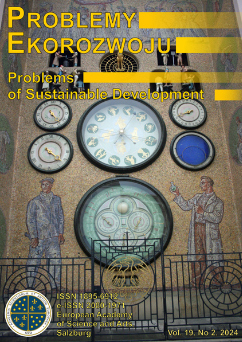Wykorzystanie podziemi: krok w kierunku zrównoważonego rozwoju w prowincji Chuzestan w Iranie
Sohrab Ghaedi
Shahid Chamran University of Ahvaz, Ahvaz, Khuzestan province, Iran, 6137873396 (Iran)
https://orcid.org/0000-0002-4016-6342
Abstrakt
Zmniejszenie zużycia paliw kopalnych z wykorzystaniem przestrzeni podziemnych ma znaczący wpływ na wymiar gospodarczy, społeczny i środowiskowy zrównoważonego rozwoju. W tym badaniu zbadano temperaturę i komfort cieplny warstw gleby w tych warstwach, aby stworzyć podziemne przestrzenie w prowincji Chuzestan. Średnia temperatura latem w centralnej części prowincji wynosi około 38 ° C, co jest dalekie od komfortowej temperatury. Roczne wahania temperatury powierzchniowej w prowincji wahają się od 23,5 °C na północy prowincji do 28,5 °C na południowym wschodzie. Badanie wahań temperatury w warstwach gleby wykazało, że zmniejsza się ona wraz ze wzrostem głębokości, tak że na głębokości 10 metrów wahania temperatury są w przybliżeniu zerowe i są równe średniej temperaturze rocznej. Dlatego do głębokości 10 m wraz z rosnącą głębokością zmniejszają się wahania temperatury. Wykorzystanie przestrzeni podziemnych w tej prowincji może być wykorzystane do walki z upałem i ekstremalnym nasłonecznieniem, ograniczania zużycia energii i kontrolowania zapylenia oraz ma pozytywny wpływ na wymiar ekonomiczny, społeczny i środowiskowy zrównoważonego rozwoju.
Słowa kluczowe:
podziemia, zmiany temperatury, temperatura głębi ziemi, komfort termiczny, prowincja KhuzestanBibliografia
ASADI S., M. FAKHARI M., SENDI M., 2016, A study on the thermal behavior of traditional residential buildings: Rasoulian house case study, in: Journal of Building Engineering 7(1), p. 334-342.
DOI: https://doi.org/10.1016/j.jobe.2016.07.012
Google Scholar
BARRADAS V. L., 1991, Air temperature and humidity and human comfort index of some city parks of Mexico City, in: International Journal of Biometeorology 35(1), 24-28.
DOI: https://doi.org/10.1007/BF01040959
Google Scholar
CHOVANCOVÁ J., VAVREK R., 2019, Decoupling Analysis of Energy Consumption and Economic Growth of V4 Countries, in: Problemy Ekorozwoju/ Problems of Sustainable Development, 14(1), p. 159-165.
Google Scholar
DANESHVAR M. R. M., BAGHERZADEH A., TAVOUSI T., 2013, Assessment of bioclimatic comfort conditions based on Physiologically Equivalent Temperature (PET) using the RayMan Model in Iran, in: Central European Journal of Geosciences 5(1), p. 53-60.
DOI: https://doi.org/10.2478/s13533-012-0118-7
Google Scholar
DEMPSEY N., BRAMLEY G., POWER S., BROWN C, 2011, The social dimension of sustainable development: Defining urban social sustainability, in: Sustainable development, 19(5), p. 289-300.
DOI: https://doi.org/10.1002/sd.417
Google Scholar
FARDPOUR T., 2013, Energy-saving patterns of Iranian Traditional Architecture in various climates, in: Advanced Materials Research 689, p. 66-70.
DOI: https://doi.org/10.4028/www.scientific.net/AMR.689.66
Google Scholar
GHAED, S., 2019, The variability and trends of monthly maximum wind speed over Iran, in: IDOJARAS 123(4), p. 521-534.
DOI: https://doi.org/10.28974/idojaras.2019.4.7
Google Scholar
GIVONI B.M., 1976, Climate and architecture, 2nd Edition, Applied science publishers, London.
Google Scholar
HAZBEI M., ADIB Z., NASROLLAHI F. 2014. Natural ventilation effect on Shavadoons in Dezful by applying CFD modeling, in: Bagh -e Nazar 11(30), p. 43-54.
Google Scholar
IPCC, 2014, Synthesis report. Contribution of working groups I, II and III to the Fifth Assessment Report of the Intergovernmental Panel on Climate Change, eds. Pachauri R.K., Meyer L.A., IPCC Geneva Switzerland 151 p.
Google Scholar
KHAKI A., SADAT S.A., 2015, Investigating the Effect of Sustainable Patterns of Iran's Traditional Architecture in Sustainable Development, in: European Online Journal of Natural and Social Sciences 3(3), p. 191-208.
Google Scholar
KHODABAKHSHIAN M., MOFIDI S. M., 2013, Advances in underground space development, 13th World Conference of Associated research centers for the urban-underground space (ACUUS), Singapore, p. 478-487.
Google Scholar
KHODABAKHSHIAN M., MOFIDI S. M., 2014, Underground Spaces in Arid Climate Architecture of Iran, in: Hoviat Shahr 8(17), p. 35-44.
Google Scholar
DEHCHESHMEH M. M., GHAEDI S., 2020, Climate Change and Ecological Migration: A Study of Villages in the Province of Khuzestan, Iran, in: Environmental Research, Engineering and Management, 76(1), p. 6-19.
DOI: https://doi.org/10.5755/j01.erem.76.1.24513
Google Scholar
RAHMANI E., 2013, Intelligent solutions to the underground spaces in Iran, Advances in underground space development, 13th World conference of associated research centers for the urban-underground space (ACUUS), Singapore, p. 83-94, https://www.acuus.org.
Google Scholar
REDDY P., 2003, Going underground a Cumbrian perspective. Technology, UK.
Google Scholar
RONKA K., RITOLA J., RAUHALA K., 1998, Underground space in land-use planning, in: Tunnelling and Underground Space Technology, 13(1), p. 39-49.
DOI: https://doi.org/10.1016/S0886-7798(98)00029-7
Google Scholar
ROSHAN G., YOUSEFI R., BŁAŻEJCZYK K., 2018, Assessment of the climatic potential for tourism in Iran through biometeorology clustering, in: International journal of biometeorology, 62(4), p. 525-542.
DOI: https://doi.org/10.1007/s00484-017-1462-6
Google Scholar
SADOOGHI A., CH. KIBERT F., MIRMOHAMMAD S., JAFARI S., 2019, Thermal performance analysis of a traditional passive cooling system in Dezful, Iran, in: Tunnelling and Underground Space Technology 83(3), p. 291-302.
DOI: https://doi.org/10.1016/j.tust.2018.09.024
Google Scholar
SCHELL L.M., GALLO M.V., RAVENSCROFT J., 2009, Environmental influences on human growth and development: historical review and case study of contemporary influences, in: Ann Hum Biol., 36(5), p. 459-77.
DOI: https://doi.org/10.1080/03014460903067159
Google Scholar
SOBCZYK W., 2015, Sustainable development of Middle East Region, in: Problemy Ekorozwoju/ Problems of sustainable development, 10(2), p. 51-62.
Google Scholar
SOFLAEI F., SHOKOUHIAN M., SOFLAEI A., 2017, Traditional courtyard houses as a model for sustainable design: A case study on BWhs mesoclimate of Iran, in: Frontiers of Architectural Research 6(3), p. 329-345.
DOI: https://doi.org/10.1016/j.foar.2017.04.004
Google Scholar
VANOS J., WARLAND J., GILLESPIE T., KENNY N., 2010, Review of the physiology of human thermal comfort while exercising in urban landscapes and implications for bioclimatic design, in: Int. J Biometeorol. 54, p. 319-334.
DOI: https://doi.org/10.1007/s00484-010-0301-9
Google Scholar
WILLIAMS K., BURTON E., JENKS M., 2000, Achieving sustainable urban form: an introduction, in: Achieving sustainable urban form, 2, p. 1-5.
DOI: https://doi.org/10.1016/S0264-8377(01)00010-2
Google Scholar
Autorzy
Sohrab GhaediShahid Chamran University of Ahvaz, Ahvaz, Khuzestan province, Iran, 6137873396 Iran
https://orcid.org/0000-0002-4016-6342
Statystyki
Abstract views: 33PDF downloads: 16
Licencja

Utwór dostępny jest na licencji Creative Commons Uznanie autorstwa – Na tych samych warunkach 4.0 Miedzynarodowe.








